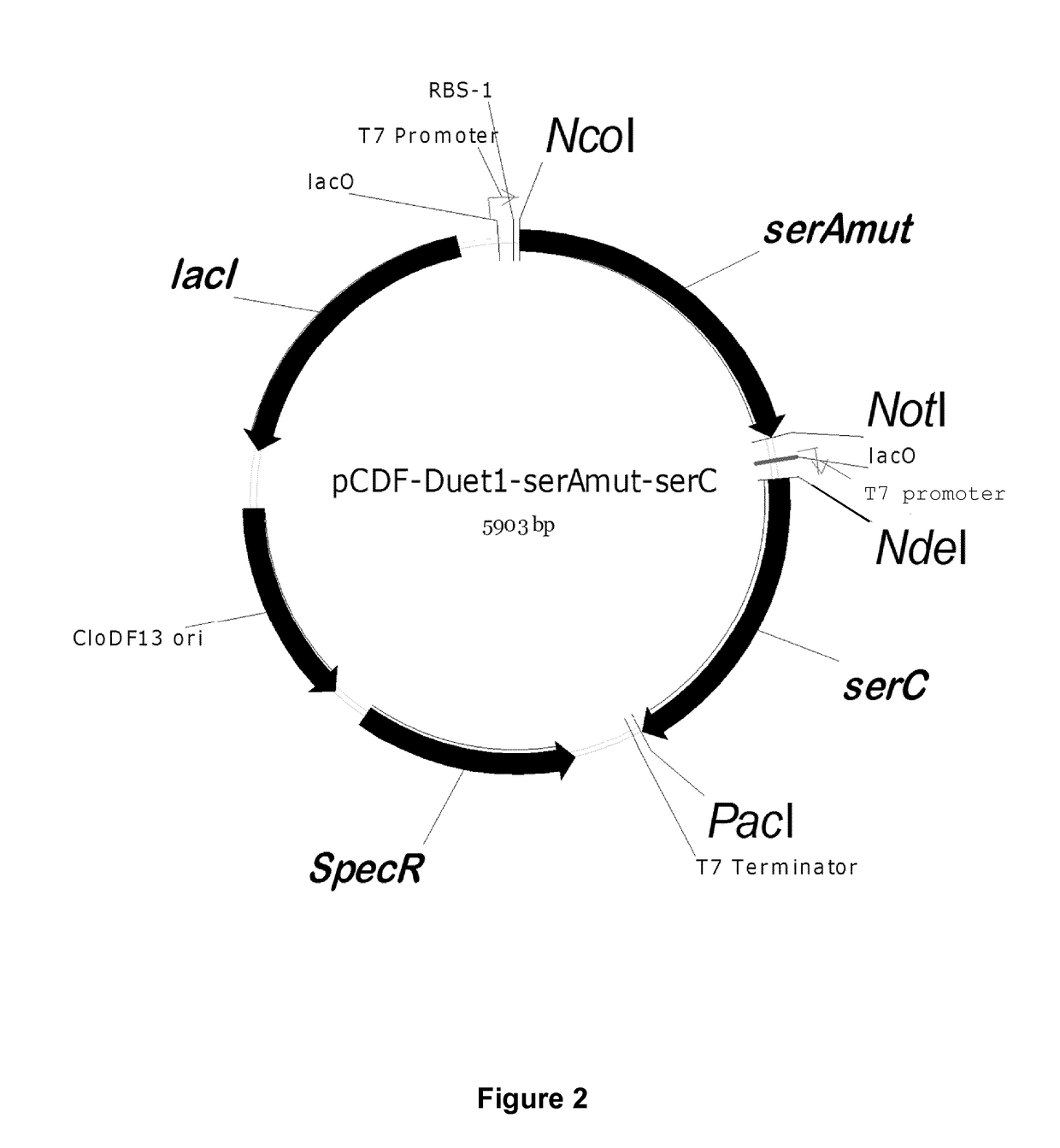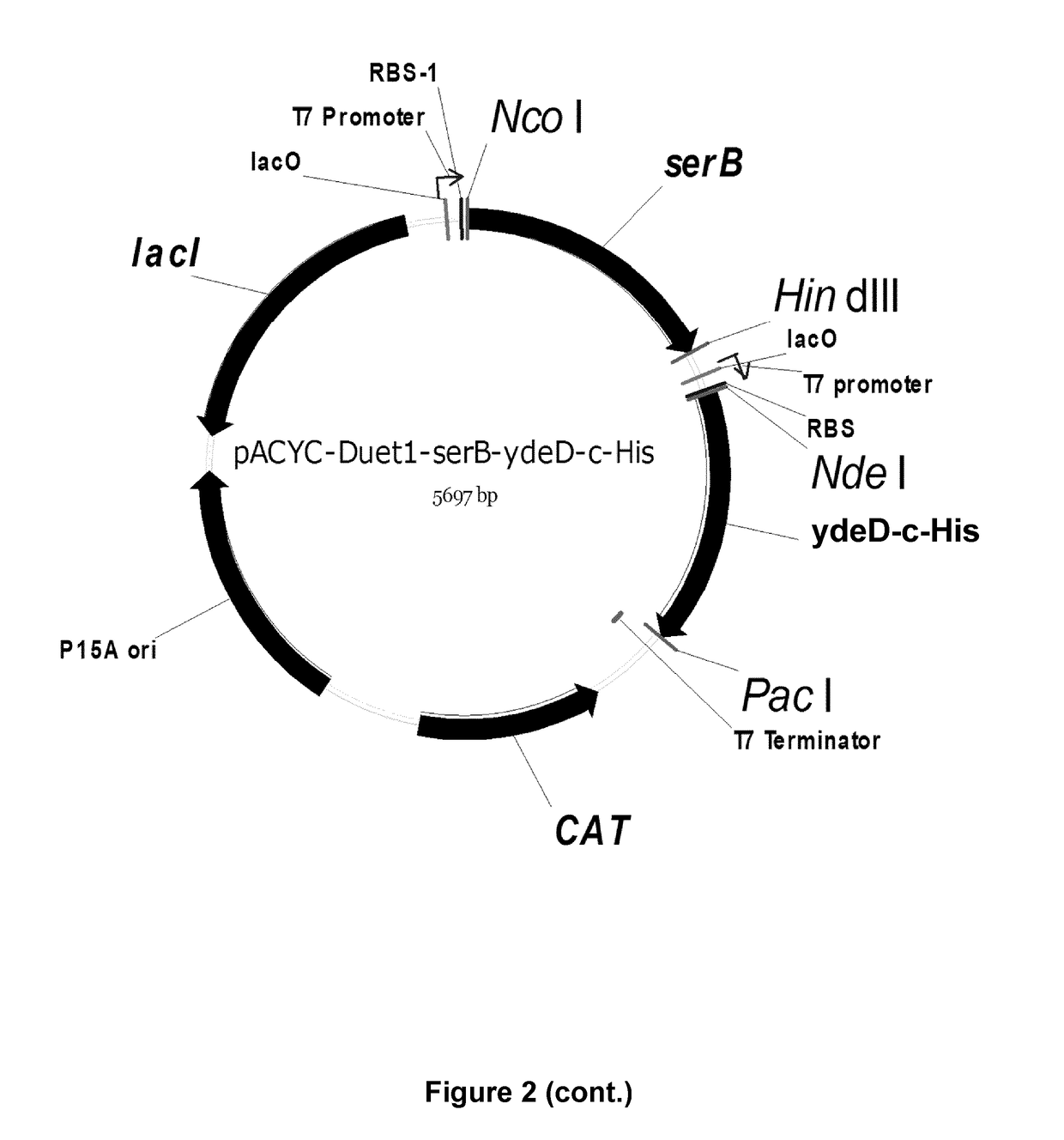Genetically modified microorganisms having improved tolerance towards l-serine
a technology of genetically modified microorganisms and lserine, which is applied in the field of genetically modified microorganisms and production of lserine, can solve the problems of high cost of glycine starting material, marginal and transient increase of serine titer, and time-consuming fermentation process, so as to improve mass yield, increase nominal yield, and efficient production of lserine
- Summary
- Abstract
- Description
- Claims
- Application Information
AI Technical Summary
Benefits of technology
Problems solved by technology
Method used
Image
Examples
example 1
of Key Degradation Pathways
[0425]Serine has two key degradation pathways in E. coli: Serine to pyruvate, which is encoded by three deaminases namely sdaA, sdaB and tdcG, and conversion of serine to glycine, which is encoded by glyA. The deletion of glyA renders E. coli auxotrophic for glycine. Deletion of sdaA, sdaB and tdcG was done sequentially by using the lambda red mediated gene replacement method (Datsenko and Wanner, 2000). The protocol applied for deleting these genes is similar to the protocol described by Sawitzke et al. (2013). Primers used for amplification of the kanamycin cassette are shown in Table S1. The PCR reaction contained 250 nM each of KF and KR primer of the given gene, 250 μM of dNTP mix, 4 Units of Phusion polymerase (Thermoscientific, Waltham, Mass., USA), 40 μl of HF buffer and 10 ng of pKD4 plasmid. The following two-step PCR protocol was used for the PCR amplification: An initial denaturation step at 98° C. for 40 seconds, followed by 5 cycles of denatu...
example 2
ssion of Serine Biosynthesis Pathway for Production of Serine
[0426]Serine is produced in E. coli from three enzymes encoded by serA, serB and serC. All genes were isolated from E. coli MG1655 using primers with respective gene names (Table S3). The 100 μl PCR mixture contain 250 nM each of forward and reverse primer, 250 μM of dNTP, 2 U of Phusion polymerase, 1×HF buffer, 1 μl of overnight culture. The following two-step PCR protocol was used for the PCR amplification: An initial denaturation step at 98° C. for 40, followed by 5 cycles of denaturation at 98° C. for 10 seconds, annealing at 55° C. for 30 seconds, extension at 72° C. for 90 seconds the cycle, followed by 20 cycles, where the annealing temperature was increased from 55° C. to 65° C. After column purification, the gene products and plasmids were digested using Fast digest enzymes (Thermoscientific, Waltham, Mass., USA). About 500 ng of PCR product or 1 μg of plasmids were subjected to digestion by 1 μl each of the restr...
example 3
Product Toxicity by Overexpression of Transporter
[0432]Deletion of the main serine degradation pathways in E. coli results in significant decreased tolerance towards serine. In order to increase the tolerance, a transporter with a potential specificity for serine (ydeD) was overexpressed and tested during growth in high concentrations of serine. ydeD was cloned in pCDF-1b at NcoI and PacI site by amplification with primers mentioned in Table S3 and the protocol given in Example 1.
[0433]Q1(DE3) was transformed with the pCDF-1b empty vector and the pCDF-ydeD-c-His plasmid (FIG. 4). Transformants were selected on LB-spectinomycin plates. Overnight cultures of these transformants were inoculated in M9 media supplemented with 2 mM glycine, 2 g / L glucose and spectinomycin in 1:50 ratio. Cultures were incubated at 37° C. and 250 rpm at an optical density of 0.4 to 0.5, after which 800 μl was added to a 48-well biolector plate (M2P labs, Baeswieler, Germany) containing 800 μl M9 media with ...
PUM
| Property | Measurement | Unit |
|---|---|---|
| concentration | aaaaa | aaaaa |
| concentration | aaaaa | aaaaa |
| concentration | aaaaa | aaaaa |
Abstract
Description
Claims
Application Information
 Login to View More
Login to View More - R&D
- Intellectual Property
- Life Sciences
- Materials
- Tech Scout
- Unparalleled Data Quality
- Higher Quality Content
- 60% Fewer Hallucinations
Browse by: Latest US Patents, China's latest patents, Technical Efficacy Thesaurus, Application Domain, Technology Topic, Popular Technical Reports.
© 2025 PatSnap. All rights reserved.Legal|Privacy policy|Modern Slavery Act Transparency Statement|Sitemap|About US| Contact US: help@patsnap.com



